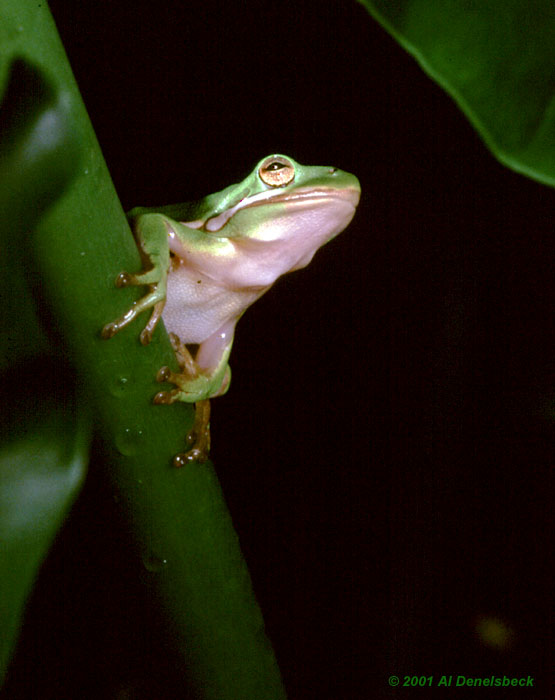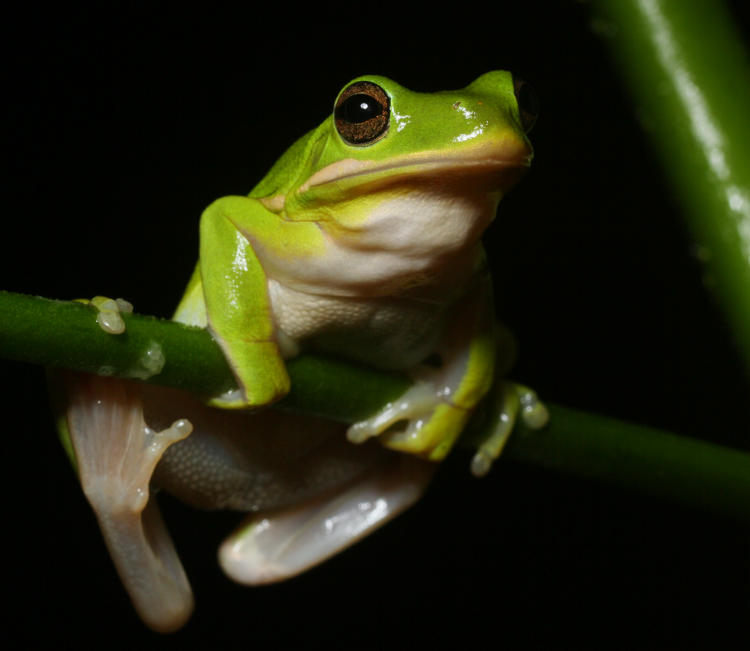And so we come to the new weekly topic for the year, which may seem a bit self-absorbed at first, but is something that I recommend to everyone because it not only helps to see the progress that you’ve been making, it points out the progress still waiting to be made. In short, it’s a comparison of an older image, preferably one that I was once proud of capturing, with something current. This was almost a singular post of its own last year that I let slide, but I recently realized that I could (perhaps) make a whole year out of it.
We begin with one that currently resides in the gallery section of the main site, taken better than twenty years ago now (the copyright date actually indicates its first publication in media, in this case the web, rather than the year it was taken since I’m not sure about this.)

At the time this was taken, I had yet to spot a green treefrog in the wild, and even finding them within the Butterfly House of the Museum of Life & Science in Durham, NC (where this was taken) was challenging; this may have been because there were very few therein, or simply because the species is nocturnal and so usually snoozing during open hours. As the position implies, I was shooting from well beneath, but this gave it a dynamic composition that I’m still pleased with. The combination of using contrasty slide film (Fuji Provia 100F) and digitally adjusting the exposure due to accidentally under-exposing the image produced, well, something that looks a little too altered.
Yes, even film cameras of that time had exposure meters, but I was using small, manual flash units strapped directly to the lens hood for macro work, since the shoe-mounted 380EX flash aimed too high for close subjects; I had yet to even get an off-camera cord to move the flash to a bracket where the aim could be adjusted, much less perform the umpteen changes that led to the current rig (and even that’s not perfectly current, because it’s since been rebuilt out of hardier materials and reshaped a little.) I had performed a plethora of lighting tests to become familiar with the little strobes’ level of light output, but neglected to account for the light loss from using a teleconverter for the shot.
That all brings us to this image from last summer.

It’s easy to see the better color and contrast, though not quite as obvious is the improved lighting – still bright enough for good detail, but not straight-on and so providing better shaping. Not at all visible are the conditions, which was in our own backyard, not captive in any way. I’d spent years without seeing the species in North Carolina, and finally started finding them sporadically when living in Florida (only a couple of years after that copyright date up there.) Upon returning to NC, I then would only see them no more than twice a year, before the move to the new place (nearly eight years ago now) where I discovered a pond that they adored. But I was still hoping to get them established closer, and this eventually happened; we’re now at the point where I see them far more frequently than the other common species (the Copes grey treefrog,) and don’t even have to travel minimally to do so. The ready availability means that I can spend the time finding more esoteric and expressive poses, as well as more behavior and various life stages.
Yet I still have the goal to produce images that don’t look like they were shot at night, even when that’s perfectly natural: more background detail, a nicely-lit setting. This will require multiple lights to even illuminate a setting, once found, and this is considerably less portable than a strobe attached to the camera. Still hashing that part out, so perhaps we’ll see a new technique by the end of the year.




















































